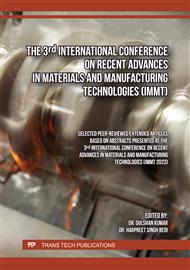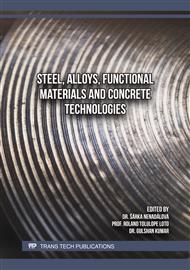p.3
p.15
p.27
p.43
p.53
p.59
p.67
p.77
Solubility of Nitrogen in Austenitic Stainless Steel
Abstract:
Modified stainless steel grade X45CrNiW 18-9 has been developed through replacement of nickel by nitrogen. The modified steels have been produced in induction furnace under nitrogen pressure and were cast into round ingots with 100 mm diameter. The cast modified stainless steels were forged, followed by air cooling. The nitrogen contents were determined and compared with those calculated using Institute of Metal Science (IMS) equation: The results showed that there are great deviations between the actual nitrogen contents and predicted values through IMS equation. So, an equation has been derived based on chemical composition, pressure and temperature at 1600 °C. [N%] = 0.0078 + 0.0406*X, where X is function of chemical composition and nitrogen pressure. The derived equation has been used to calculate the nitrogen content of different stainless steels using published data. The results reveal the difficulty of deriving a general equation for the prediction of nitrogen content covering different steel compositions. So it is necessary to use narrow composition range. The phases of modified stainless steels have been investigated using Schaeffler diagram, dilatometer and microstructure observations. Both partial and total replacement of nickel using 0.33-0.50% nitrogen, are effective to produce a modified fully austenitic stainless steel grade X45CrNiW 18-9.
Info:
Periodical:
Pages:
43-52
Citation:
Online since:
May 2025
Authors:
Keywords:
Price:
Сopyright:
© 2025 Trans Tech Publications Ltd. All Rights Reserved
Share:
Citation:



